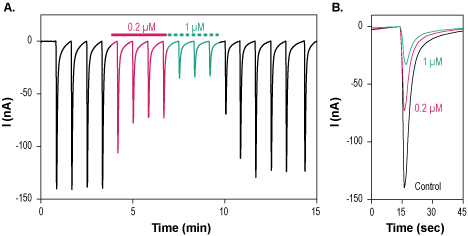Overview
- Dowell, C. et al. (2003) J. Neurosci. 23, 8445.
- Chi, S.W. et al. (2005) Biochem. Biophys. Res. Commun. 338, 1990.
 Alomone Labs α-Conotoxin PIA inhibits α3/β2 nAChR heterologously expressed in Xenopus oocytes.A. Time course of α-Conotoxin PIA (#STC-870) blocking action on α3/β2 nAChR. Current amplitude were plotted as a function of time. Membrane potential was held at -80 mV and oocyte were stimulated by exposure to 10 µM ACh every 50 sec. 0.2 µM (red) and 1 µM (green) (each for 3 min) α-Conotoxin PIA were perfused during the period marked by the bar, as indicated. B. Superimposed traces of α3/β2 nAChR channel current in the absence (black) and presence of different concentrations of α-Conotoxin PIA (taken from experiment in A).
Alomone Labs α-Conotoxin PIA inhibits α3/β2 nAChR heterologously expressed in Xenopus oocytes.A. Time course of α-Conotoxin PIA (#STC-870) blocking action on α3/β2 nAChR. Current amplitude were plotted as a function of time. Membrane potential was held at -80 mV and oocyte were stimulated by exposure to 10 µM ACh every 50 sec. 0.2 µM (red) and 1 µM (green) (each for 3 min) α-Conotoxin PIA were perfused during the period marked by the bar, as indicated. B. Superimposed traces of α3/β2 nAChR channel current in the absence (black) and presence of different concentrations of α-Conotoxin PIA (taken from experiment in A).
α-Conotoxin PIA is a peptide toxin originally isolated from Conus purpurascens and belongs to the A superfamily of conotoxins. It is a selective antagonist for heteromeric α6 subunit -containing nicotinic acetylcholine receptors (nAChR). α-Conotoxin PIA binds on the extracellular portion of the nAChR and distinguishes α6 from α3 subunits due to its lower affinity for α3.
The alpha-conotoxin PIA has an "omega-shaped" overall topology, containing spacing of Cys residues, disulfide connectivity, and the SNPV (serine, asparagine, proline, valine) sequence in the first peptide loop. The second loop demonstrates a kink in Pro15 that provides a distinct steric and electrostatic environment1-3.
Evidence has shown that α-conotoxin PIA has the ability to potently block nicotine-stimulated dopamine release in rat striatal synaptosomes with low nanomolar potency1. Indeed, the IC50 value for α-conotoxin PIA of human chimeric α6/α3/β2/β3 nAChRs is 1.7 nM1.
Nicotinic acetylcholine receptors containing α6 subunits in the CNS are involved in a variety of physiological functions, and considered to play an important role in cognitive function, motor activity, pain perception, analgesia and the reinforcing properties of nicotine.
They are implicated in the pathophysiology and treatment of diseases like chronic Parkinson's, and Alzheimer's1.

